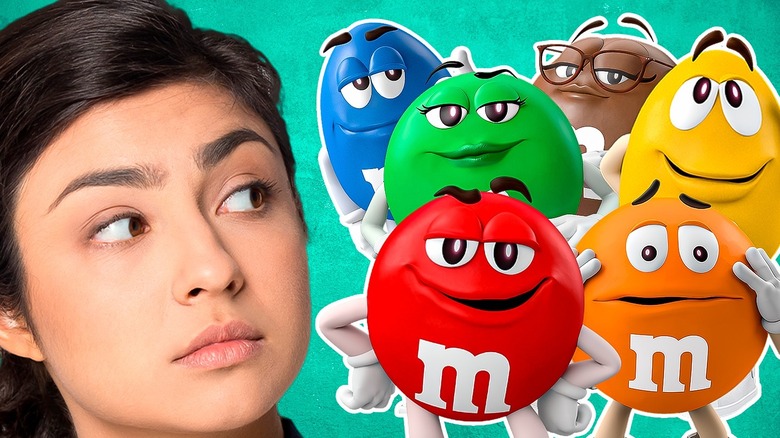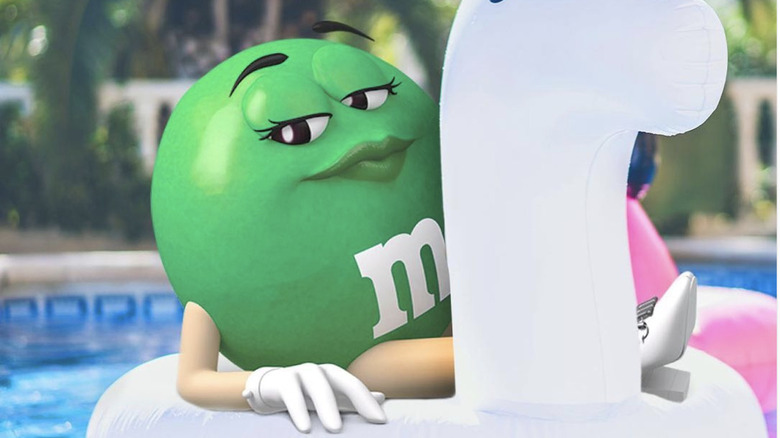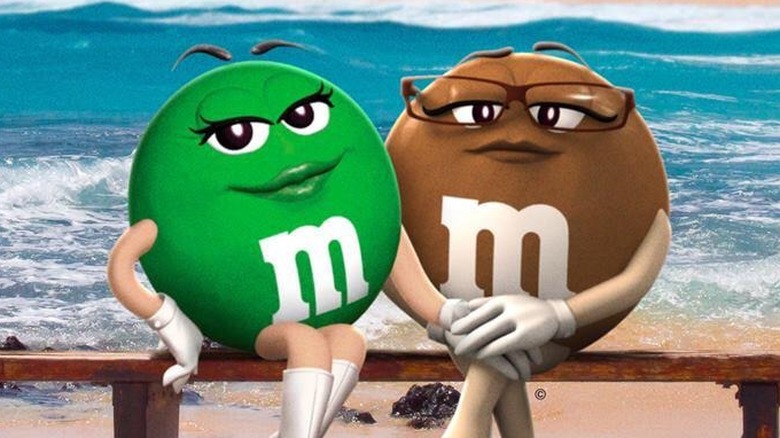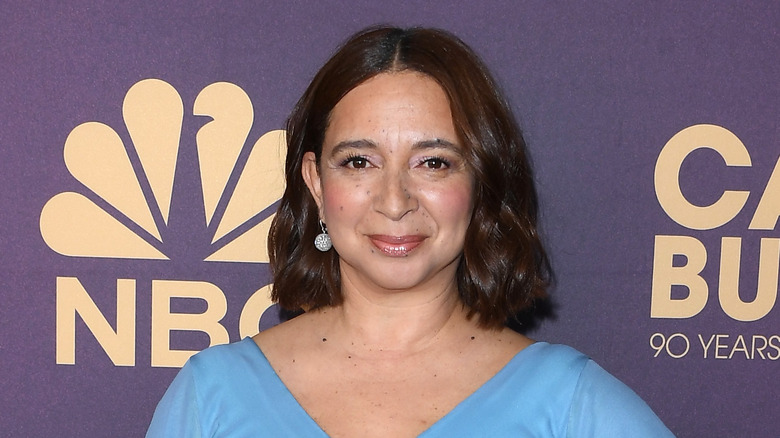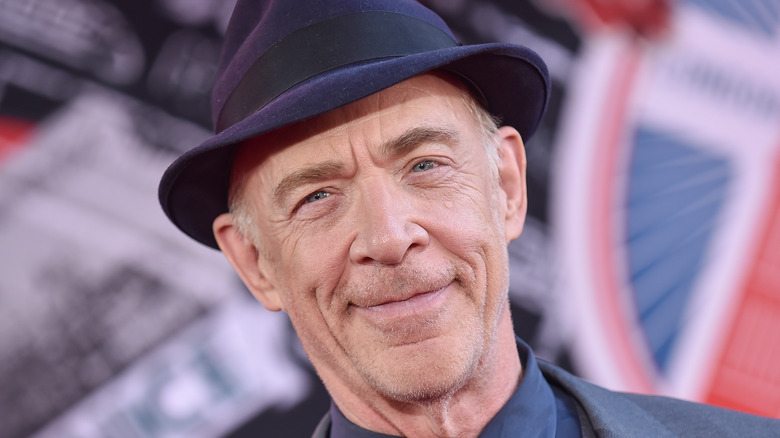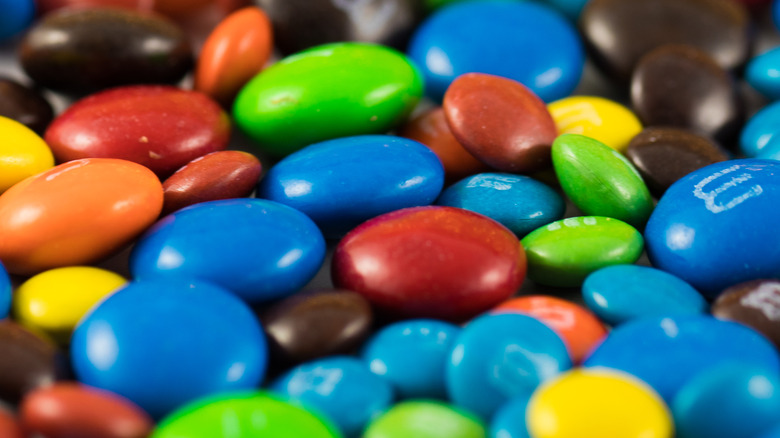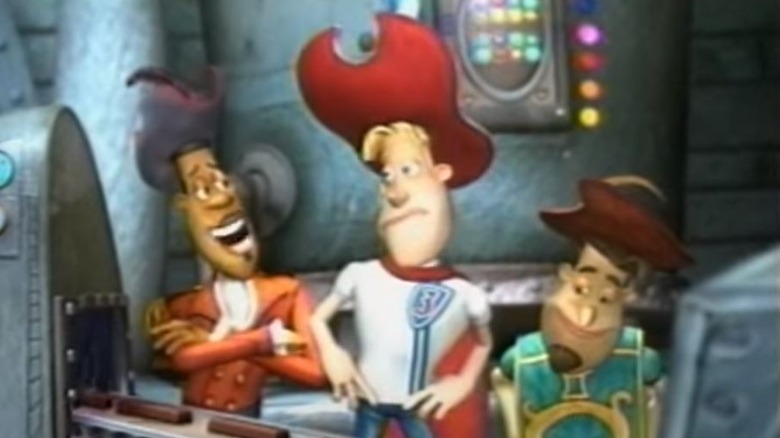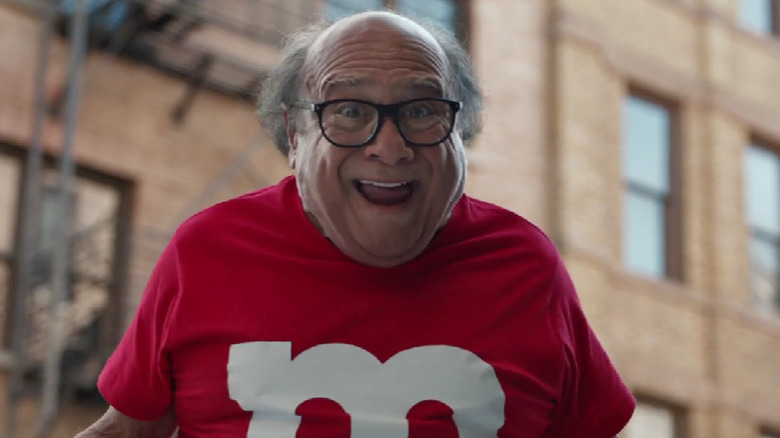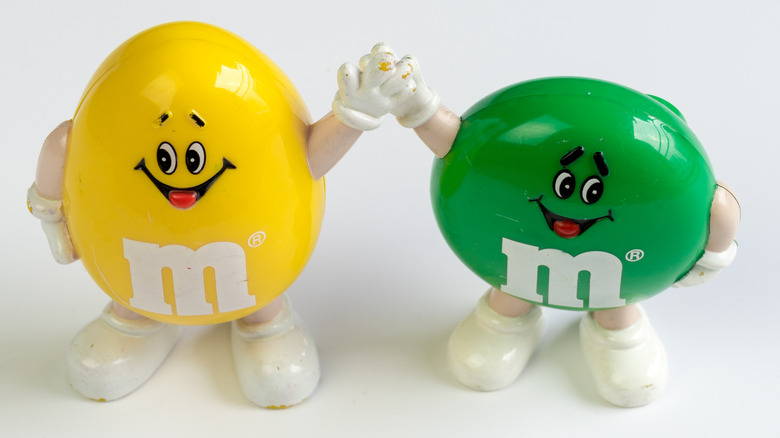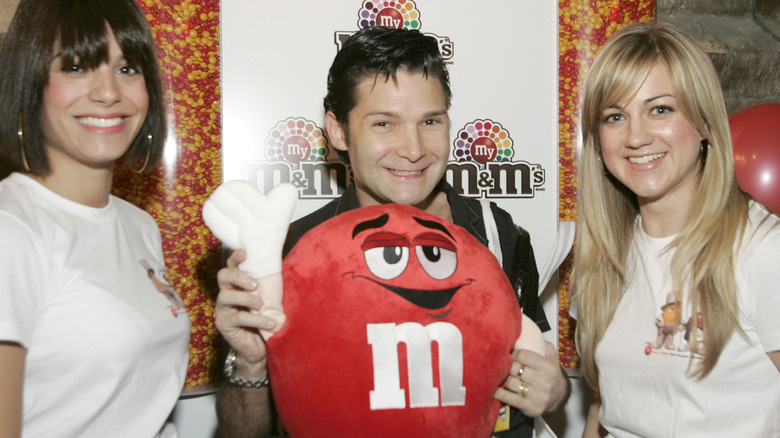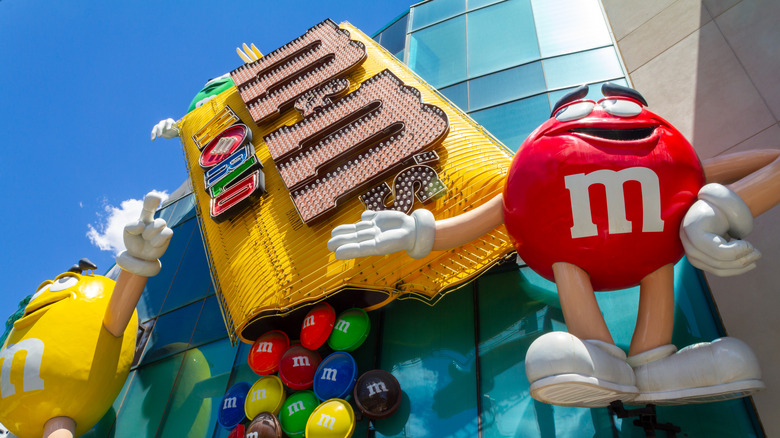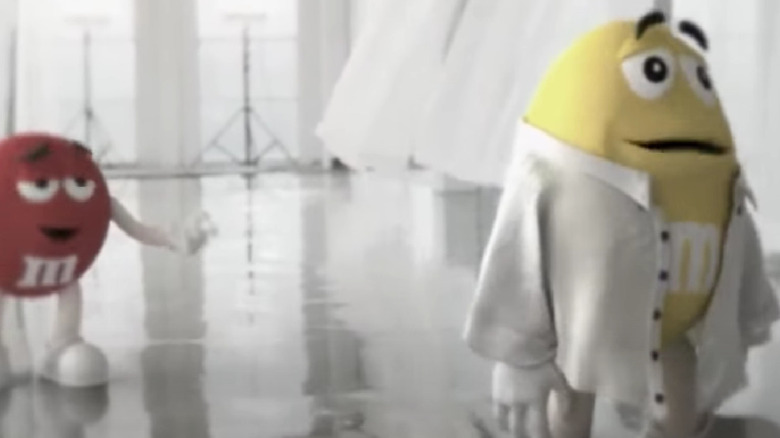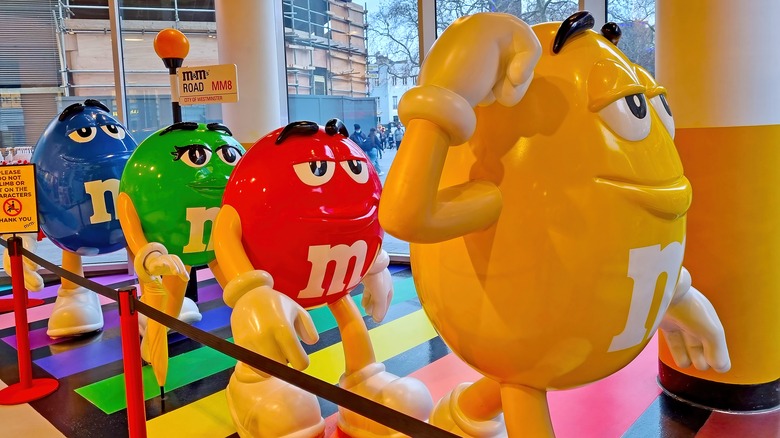Things Only Adults Notice About The M&M's Spokescandies
Childhood is a stage of life characterized by fun, innocence, and a naive love for candy mascots. However, content targeted at kids often takes on a more disturbing context when revisited from an adult's viewpoint. The M&M's spokescandies are a perfect example of this. While you won't find any subliminal messaging in M&M's commercials, many details of the M&M's universe are downright unusual when you scrutinize them with the mind of an adult. Of course, a little weirdness should be expected in a world full of walking, talking candy.
In order to fully understand and appreciate the spokescandies, it is helpful to familiarize yourself with the history of M&M's candy. These candy-coated chocolate pieces first debuted in 1941 as a military ration in World War II. They were exclusively sold to the U.S. military before eventually being marketed to the public after the war was over. The Mars Corporation first brought the spokescandies into existence in 1960, and their immediate success set the brand down a path toward media dominance. The spokescandies truly hit their stride in the '90s when they were rendered with CGI technology by Blue Sky Studios. This kicked off the modern marketing campaign that would come to define this colorful chocolate candy's role in today's media landscape. M&M's have been a ubiquitous sight at the movie theater, in the grocery store, and on TV for decades. And anywhere you spot this colorful confection you can also expect to see the spokescandies too.
It's kind of weird that Green is hot
From the television debut of Green's character in 1997, she has served as a vessel to convey sex appeal in M&M's commercials. But as problematic as it is that the first female candy's personality is encapsulated by her feminine figure, it doesn't seem all that unusual when you are a kid. It is only once you grow up that you realize how bizarre it is that Green exhibits any sexuality whatsoever. But the unusual part isn't the use of sex for advertising. That is a common technique across the ad industry. The weird part is that she is a candy.
That said, some hardcore M&M's fans have grown very accustomed to the sexy spokescandy. And so controversy naturally arose when the Mars Corporation swapped Green's classic high-heeled go-go boots for a pair of sneakers in order to reflect a more modern understanding of gender norms. Ms. Brown also had her footwear redesigned, transitioning from stiletto heels to block heels. Conservative pundit Tucker Carlson expressed his outrage publicly and his fans followed suit. This is surprisingly not the only time that the M&M's spokescandies got caught up in political hysteria.
They sparked political controversy
As it turns out, changing the default footwear of Green and Brown to more practical options was not the only controversy instigated by the Mars Corporation's effort to make the M&M's spokescandies more inclusive in 2023. The company caused another commotion when it released a limited edition product whose packaging design supported women flipping the status quo. The package featured a new character, Purple, who was supposed to represent body positivity. This marketing drew the ire of Tucker Carlson, who mocked it on a segment of his show.
The package also featured Green and Brown, who in the past have been portrayed as lesbians. One piece of 2015 marketing material (pictured above) rebranded Green and Brown as a proud lesbian couple with a tweeted photo of the two spokescandies holding hands on the beach. The caption read, "It's rare Ms. Brown and I get to spend time together without some colorful characters barging in. – Ms. Green." At the time, the photo was fervently applauded by LGBT rights activists, who flocked to the defense of Green and Brown's relationship (via The Pink News).
Apparently, the combination of body positivity, queerness, and comfortable clothing displayed by the spokescandies was too much for the world to handle. Or perhaps Mr. Carlson's reaction was simply blown out of proportion. In any case, the backlash was so brutal that the Mars Corporation's next advertising campaign involved replacing the M&M's spokescandies altogether. This is why we can't have nice things.
They can disappear in an instant if people stop liking them
After suffering the negative consequences of back-to-back controversies related to the M&M's spokescandies, the Mars Corporation decided that the next move for its chocolate company would be to replace the mascots altogether. And that's how the spokescandies were replaced by actor Maya Rudolph in January 2023.
The company announced this in a press release in which it also acknowledged the divisiveness of rebranding the spokescandies. Ms. Rudolph did an admirable job filling the (apparently controversial) shoes of her predecessors but her tenure as the company's "Chief of Fun" was ultimately short-lived. The M&M's spokescandies made their triumphant return in two halftime commercials during Super Bowl LVII in February 2023. The commercials claimed that the spokescandies were back for good, but who knows for sure?
As a child, it is easy to overlook the politics of it all. But as an adult, it is hard not to think about just how close we really were to losing the M&M's spokescandies for good. That's not to say that it would have been all that bad to keep Maya; she's a treasure.
The voice actors are famous
While the M&M's spokescandies have been voiced by a rotating cast over the years, the M&M's marketing team has always made it a point to field top-caliber voice actors. And the voices that today's readers would be most familiar with are also some of the biggest stars in Hollywood.
For example, Billy West voices not only the Red M&M but also a huge carousel of cartoon characters including Philip J. Fry on "Futurama," Doug Funnie on "Doug," and the titular characters on "Ren and Stimpy." Jon Lovitz has also voiced Red in the past. Yellow is voiced by screen actor J.K. Simmons, who has starred in Hollywood films like "Whiplash" and "Spider-Man." Blue is voiced by television actor Robb Pruitt. Green is voiced by Cree Summer, who also voices Abigail Lincoln on "Codename: Kids Next Door" and Susie Carmichael in some versions of "The Rugrats." Ms. Brown is voiced by Vanessa Williams, who is known for her successful singing career and for winning Miss America 1984.
The list runs so deep that you will even find famous actors playing bit parts in M&M's commercials. Phil Hartman has voiced the role of a generic rival company's chocolate bar and David Cross has played the short-lived role of Caramel. The Mars Corporation clearly has a substantial advertising budget to pull this much star power.
They follow the ideas of color psychology
The fact that the M&M's spokescandies are a colorful bunch may be a simple detail but it is not without meaning. It is only as an adult that you begin to question why M&M's have such a colorful coating.
The simple answer is that a colorful product more easily catches the eye in a store. But the logic of color psychology goes far deeper when you factor in the role that the mascots play. Colors have a profound effect on our moods, and each color is subliminally connected to different human emotions. As a whole, the colorful M&M's spokescandies represent a wide spectrum of personality types, making them more appealing to a wide range of consumers. The personality of each spokescandy is represented by its color.
All of the spokescandies are color-coded in a way that closely aligns with the theory of color psychology. Red is the leader of the group and his color is that of energy, strength, and passion. Meanwhile Yellow is characterized as the bumbling sidekick just as the color yellow evokes loyalty, warmth, and optimism. Green is the color of growth and fertility. And the list goes on. These connections might not align with every culture's interpretation of color theory but the association is there. Suffice it to say, the whole gang is perfectly suited to a personality quiz.
They are distant relatives of the 3 Musketeers
Unless you are a fan of 19th-century literature, the swashbuckling 3 Musketeers are notably less recognizable than the M&M's spokescandies. However, both chocolate mascot teams have some key similarities. The most notable is that they were both developed by the same parent company, the Mars Corporation.
And while the original two spokescandies predate Mars' Musketeers mascots by several decades, both brands modernized with CGI mascots around the same time. The first modern commercials with the 3 Musketeers mascots came in 1998, right around the time that Blue was added to the spokescandy roster.
Being the audacious lot that they are, the Musketeers are typically depicted adventuring in search of their fluffy chocolate treasure. The spokescandies' adventures are slightly more mundane in comparison but still focus on extolling the virtues of candy.
Given all of this information, it is surprising that the M&M's universe never crossed over into the 3 Musketeers universe. That surely would have softened the blow of growing older and realizing that all of these figures are soulless corporate marketing tools.
They are canonically clothed and bald
As a kid, you are likely more focused on when you can next eat M&M's rather than whether or not the M&M's spokescandies are mammals. And yet, this topic is hard to ignore when watching an M&M's commercials as a learned adult.
As it turns out, M&M's commercials have depicted these anthropomorphic candies with hair, which firmly establishes them as a member of the mammalian kingdom. It also establishes that the brand's most iconic figures are actually all bald. Yes, it's lore-accurate. In one particularly enlightening commercial, Red wishes upon a lucky penny to turn human, at which point he morphs into Danny DeVito. Then at the end of the commercial, Brown says, "you're still short and bald." Ouch.
Weirder yet, their candy shells are considered clothes. The spokescandies have been depicted removing their candy shell like it is clothing. Nobody said the physiology of the M&M's spokescandies had to make sense, but it also didn't have to be this weird. Ignorance is bliss, kids.
The oldest M&M's are technically baby boomers
When a cartoon character doesn't visibly age or discuss aging, a child will never think twice about their immortal status. However, we adults cannot help but try to understand fictional characters with the same lens of mortality we apply to ourselves. And applying this lens reveals the fact that the oldest M&M's are technically boomers.
The original two spokescandies, Red and Yellow, were first created in 1960, which by definition, makes them members of the baby boomer generation. That said, the spokescandies at large are a fairly age-diverse group. Blue was added in 1995, making him the millennial of the lot. Green and Orange were added shortly after in 1997 and 1999 respectively, making them Generation Z. Ms. Brown was added in 2012, so she's technically Generation Alpha despite having the most mature personality.
All this said, the M&M's don't explicitly act their age. But for all we know M&M's spokescandies mature differently from humans. One detail that is hard to ignore is that the advertising sensibilities of the M&M's brand have evolved with each new generation of consumers. So, in a way, each spokescandy has stayed true to its generational roots. This may have even had something to do with Green's earlier-mentioned footwear controversy.
They are a part of the Hollywood in-crowd
While the M&M's brand has had plenty of advertising campaigns directly targeted at the youth audience, it has also leveraged the popularity of several Hollywood A-Listers to advertise to its more celebrity-obsessed adult customers. In fact, the spokescandies are so regularly involved in show business that they even canonically have their own Hollywood agent. And it makes sense for them to have an agent considering the level of talent that they regularly work with.
There have been numerous M&M's commercials over the years that reveal the celebrity connections of the various spokescandies. Red is personal friends with Patrick Warburton. Blue has worked alongside Stephen Baldwin. Orange got to meet Carson Daly one time. Brown made an official cameo on "The Celebrity Apprentice." The crew has even met fellow CGI Stars like Shrek and Optimus Prime. And that's to say nothing of the countless other celebrities cited in this article. But despite getting to rub elbows with some elite actors, most of the spokescandies are clearly pretty humble. They can be seen watching movies even more often than they can be seen starring in them. Plus, they usually greet other celebrities with admiration and humility. Usually.
They brazenly engage in cannibalism
Yes, the M&M's have eaten M&M's on multiple occasions. As stand-ins for humans, the spokescandies have acknowledged how delicious milk chocolate is, as well as the fact that they are made from the exact same material. As fun a concept as this may be in commercials, it is undoubtedly disturbing to adults. And that goes double for adults who have consumed an unhealthy amount of true crime content. Don't worry though, the spokescandies consumed non-anthropomorphized M&M's so there was no pain or screaming involved. It was still quite disturbing, though.
Even when they aren't explicitly cannibalizing their own kind, the spokescandies are constantly discussing how delicious and desirable they are to humans. In fact, one of the most common premises for M&M's commercials is one or more of the spokescandies trying to avoid the attention of a hungry human. Being this delectable is clearly a source of anxiety for these chocolate mascots, especially poor, worried Orange.
Their relationships are profound and complicated
Like any real group of coworkers, the M&M's spokecandies all have their own individual styles and personalities. That means that they don't always get along. But the entire context of their interpersonal relationships transforms once you grow up and experience coworker conflict firsthand. Suddenly, what looks like a typical farce to a child becomes a reflection of authentic real-world drama to an adult. Indeed, the spokescandies are flawed and tortured just like us humans.
The most salient example is the friendship of Red and Yellow. They have been friends since they first appeared in a commercial together yet their friendship has been strained to the point of breakup many times. This is an all too real response to the stresses that come from working closely alongside a friend. Sometimes business gets in the way, like when they had to compete against one another in the Vote For Your Favorite Character contest that ran in 2010. Red being more focused on romance than his friendship with Yellow is another recurrent theme, which to an adult viewer may suggest that the M&M's would strongly benefit from therapy.
They represent a massive media franchise
It is easily lost on the young mind just how massive any given company has to be in order to establish the kind of brand recognition achieved by M&M's. But once you see the sheer scale of media campaigning that is required to achieve international success, you cannot unsee it.
M&M's are everywhere. And it took a heaping pile of money to get them there. You can spot M&M's on TV and on all varieties of licensed merchandise. They even accompanied multiple U.S. space missions. The spokescandies have starred in dozens of commercials (including high-profile Super Bowl commercials) as well as video games like "M&M's Adventure."
Most of today's readers have grown up with this chocolatey treat, and even those who haven't surely know about them by now. And the Mars Corporation undoubtedly owes much of its success to the influence of the spokescandies. As previously mentioned, their fate is not a certain thing, but chances are that the spokescandies will continue to be a part of the candy marketing landscape for many years to come.
